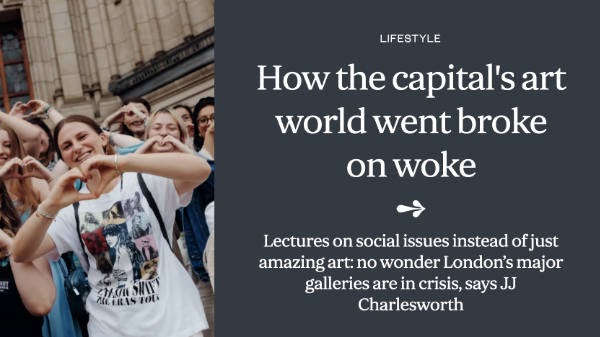
This isn’t as much a blog post by me, as me alerting you to an interesting article in The Evening Standard on 30th January. It’s a very interesting article which I think will resonate with a lot of people – and it’s a RECOMMENDED READ from me.
How the capital’s art world went broke on woke alerted me to a few things I didn’t know before
The author JJ Charlesworth is an art critic, art magazine editor and writer with twenty-five years of experience in contemporary art, publishing and education. Since 2006 he has worked on the editorial staff of the London-based international art magazine ArtReview, where he is one of the editors. He says he has also lectured and taught extensively, tutoring at London’s Royal College of Art, the Royal Academy Schools and Central St Martins College
Below I summarise
- key points from what he has to say
- commentary from me – marked up as “ME“
So what does he have to say?
Here’s some key points:
Major financial challenges
- major art institutions in London face major financial challenges
- the Tate and the Royal Academy of Arts have announced serious deficits (£11million and £2 million respectively)
Changing agendas do not bring in punters
Over the past few years art galleries have been pursuing programming agendas that don’t always resonate with audiences.
- culture wars (decolonisation / identity politics / Just Stop Oil etc etc) are not attractive to many exhibition visitors
- whereas major art galleries can host sell-out exhibitions for major “old favourite” artists from the past (e.g. Monet at the Courtauld; Van Gogh at the National Gallery in 2024)
ME: I think he’s got a very important point.
He highlights all the “we’ve not done these well in the past” / woke aspects which galleries and museums have attempted – and quotes some very underwhelming figures for certain exhibitions – which underline his point.
What people like
He highlights how the V&A has managed to do well
The V&A’s relative success in coming back from the lockdowns might be put down to its assiduously popular programming, particularly in its often-barnstorming shows focusing on fashion and pop icons
Essentially, the issue of what gets shown relates to
- what interests curators and
- what interests people at large
- they very often aren’t the same thing
The risk with agenda-led approaches is that by shaping exhibitions around what museums think of as particular identity groups or social agendas, shows end up addressing audiences as different “niches”, while alienating those who are less interested, or even antagonistic to, issues such as climate change.
There are some surprises. A recent survey by the Audience Agency (ME: which/where?) found
- only 35 per cent of visitors under 45 years of age thought venues should demonstrate a strong position on social and climate change.
- not interested in climate change:
- 65 per cent of young people aren’t interested
- 78 per cent among oldies over 45
ME: You can’t run (i.e. finance) an art gallery/museum by focusing on topics that don’t bring in the punters – no matter how noble the cause.
What people are like
The question arises as to whether the reasons for which shows people gravitate towards and which they stay away from relates fundamentally to what people are like
Are museum visitors, for example, just a more conservative, stuck-in-their-ways, traditional demographic?
ME: I think I might be described like that. However there’s something inside me which says I like seeing good art – not art which is representative of a particular set of people at a particular time who may have been ignored in the past.
ME: Surely, if we’re now more open to art by more artists, we ought to still be focusing on what is good?
The reality is that research is suggesting that political alienation results in public irritation – and a lack of attendances.
In principle, art museums and galleries should appeal to all social groups and all ages.
However some of the institutions would like to change us to fit better with what they want to do!
If museums tried connecting with audiences rather than preaching to them, they might discover what we want to see
ME: Spot on!
“you can never tell if an exhibition will be a blockbuster. What you must do is bet on talent” Will Gompertz







